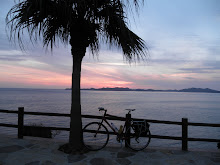129.6 km; 5hr 42min; (22.6km/h) Temples 44-59
A mixed day today, great descents then confused and backtracking followed by great coastline then a time trial finish across the rice fields.
The rising sun is my alarm clock as usual now. I'm going to buy one of those self inflating ground mats before my next tour, they're super comfortable even on a concrete floor and roll up into a tiny space. Thanks Nakata san! Glad not to be feeling any effects from last nights sake session.
Look for my sunglasses everywhere, but not to be found. I cycle about a km then head back to the hotel, look around the car park where I first parked my bike but then give them up as lost. Pretty scratched up anyway, I'm always losing or sitting on sunglasses.
Very nice to visit the mountain temples, such as temple 44 Daihoji, early in the morning while the morning mist still lingers on the mountain tops, it adds to the ambiance of the surroundings. Beyond here there's a small bump in the road, then its descend the 800m we climbed yesterday and travel north towards Matsumoto. Among the best descents here, and even more pleased that its downhill all the way, a feared steep ridge beyond the main road never appears and we are soon down the mountain and on the flat plains again.
The temple bagging goes into full effect today. I somehow miss temple 49, due to it being so close to 48 and 50. NO help from Family Mart or passers by, but now I realise I was asking directions for Ishiteji which is temple 51 so they were pointing me beyond temple 49. What would happen if I missed a temple on the route, would I go back one day just to complete my nokyocho? I'm not sure, but it would always nag me if single temple had been missed. Anyway its a short backtrack so the order is 50, 49, 51.
Ishiteji is among the most memorable temples on Shikoku, and must be one of the highlights of Matsuyama. Large in scale in every way, very impressive pagoda and huge temple lanterns on the hondo. Also one of the biggest incense burners by the hondo, the air is really thick with smoke here.
I stop by Dogo onsen, which is one of the oldest and best-known onsen hot springs in Japan, with a history stretching back over 3,000 years. The main building in the anime movie Spirited Away was modeled on the building. However its Golden Week, and the queues are large. It would take me one hour to get into the baths and as I would only get sweaty again cycling after the bath it doesn't seem worth the wait. Plus there are many temples waiting on my meguri! So instead I eat opposite the onsen and watch the passers by, the rickshaw runners trying to attract business and the various street artists playing to the large tourist presence here.
This would be a great place to end a day on the road, but its midday for me so I head on after refueling with some nice udon.
Temples 52 and 53 are still in the Matsuyama city limits then the urbanity clears up and we have some excellent coastal riding around the north-westerly part of Shikoku. The roads here were much more pleasant than expected - not heavy traffic, views across the inland sea and many sandy beaches beside the road.
Why so many temples around Imabari? I don't know but there's a large cluster of unremarkable temples around this area. I realise that I can get as far as temple 59 before 5pm, and as this would leave me a clear run in the morning to the big ascent to temple 60, the peddles are turning faster between temples as the pace increases.
Its all going well, until temple 58 - Senyuji, as up till this point I had been sailing around these coastal temples at great ease. But the approach to Senyuji suddenly rose, and the road signs still said 2km to go! Not far, but 2km up hill the time really ticks by and then a long hike up from the car park to the temple really turns the plan upside down. I never race around the actual temple area, its always good to relax and treat the temples with respect, but after I've got my nokyocho stamped its a semi-run back down to the bike then follow the henro signs towards temple 59.
No time to look at the maps now, I put all my faith in the henro footpath signs. They have to be the shortest route, and there doesn't seem to be any major obstructions in the journey here, but its a real maze of roads if I miss a sign I'll be lost in the concrete and have to end up spending the night somewhere in the edge of this urban area.
It all goes well, the signs are small but I don't miss one and I make it to 59, Kokubinji before 5pm. I'm not the only henor racing here, there are several other latecomers as I relax and head south to the next onsen marked on the road map.
Theres a large michi no eki not too far south of temple 59 with a great onsen, decent food and a huge area to camp on. I meet some American cycle tourists here, they'd cycled New York to San Francisco last year but over here there route seems less definite. They've cycled over the bridges from the mainland and hope to get to Osaka.
Sunglasses reappear, wrapped up in my tent - this is not the last time I manage to do this. Good thing I didn't buy the 30,000yen Oakleys in the Imabari bike shop earlier!






















